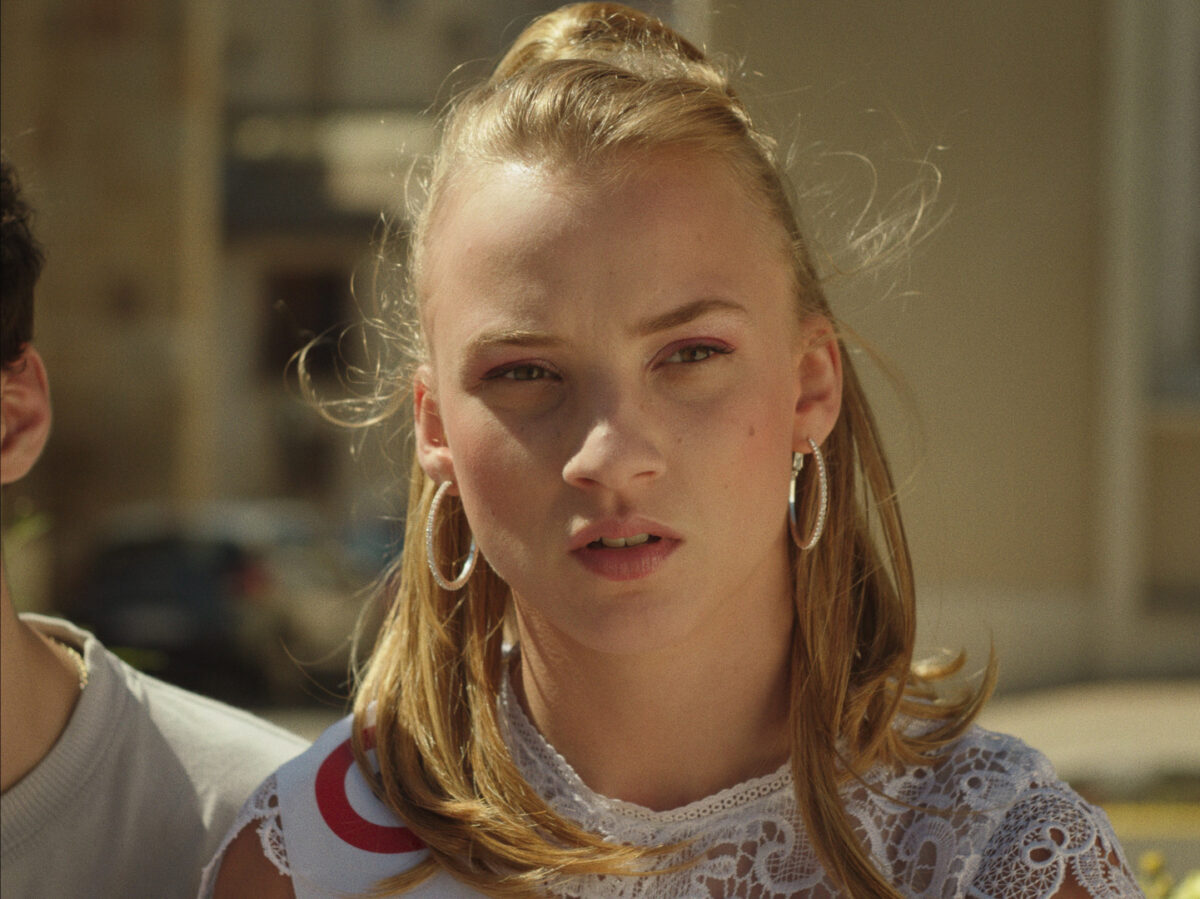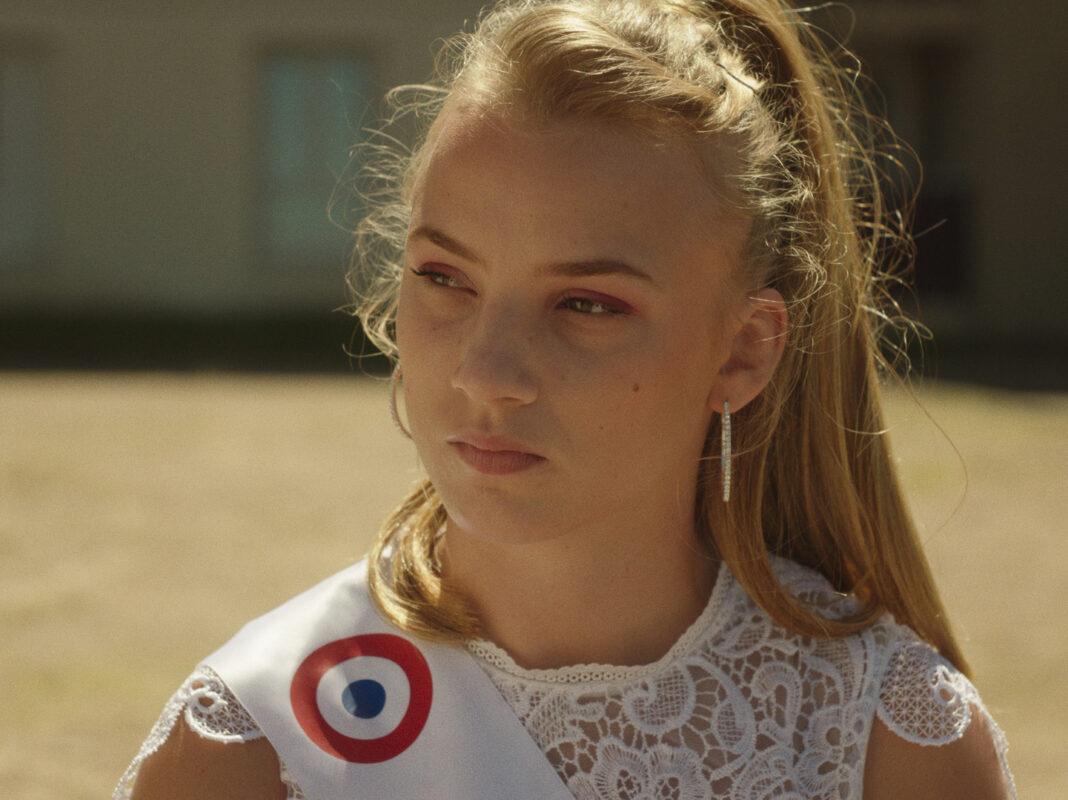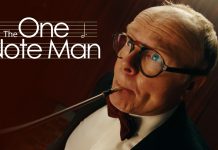The evident emotional and physical challenges from trying to be the best at a beauty pageant, coupled with the rivalry between two girls and the angry rivalry between locals, comes to the fore in Thomas Vernay’s short drama MISS CHAZELLES.
Film and TV Now recently spoke with the director about his film and the background to making it.
FILM AND TV NOW: The film taps into that affectionate coming-of-age vibe we’ve seen in films like HEAVENLY CREATURES and BOOKSMART amongst others, plus a touch of DROP DEAD GORGEOUS thematically. Were the characters based on anyone in particular?
THOMAS VERNAY: I think these references are quite far from the film. They ride between sarcasm, the grotesque and comedy. And most of them do this very well. Miss Chazelles is quite simply situated in drama.
I wrote the characters that I myself used to rub shoulders with in Chazelles-sur-Lyon in my youth. They are all based on real life, although inevitably slightly romanticised. I recall groups of boys standing around on the square, making so much noise with their motocross bikes. My cousin and I even managed to get into a fight with them, because we weren’t allowed to play on their ”territory”.
During summer, you get terribly bored in this kind of village. There’s nothing to do, and the slightest problem, the smallest event, takes on epic proportions. In hindsight, it’s quite fascinating.
Clara’s character is a bit different, as I wrote it with Megan Northam in mind for the part. I subsequently adapted the film, the writing and the stage production around that character. I knew what I wanted from her, what she was capable of doing on screen. And what she was going to bring to the film.
FTVN : The film is shot in the old Academy (1.33:1) ratio, which makes it suggestive of vintage 1970s cinema from France. How much of an influence is the old style of that time on your short?
TV: I don’t know if I was inspired by French 70’s cinema, maybe rather the naturalist side of the 60s, without realising. I used the ratio to lock the character in, to accentuate her constant feeling of suffocation. The cage of human condition.
My real influences are rather on the contemporary side of cinema, like Andrea Arnold, Jane Campion or Gus Van Sant. I like cinematography that mixes softness and power, using vibrant characters, attentive artistic direction and touching stories.

FTVN: There is an interesting mix of costume in the film, the very colourful attire the lead girl protagonists wear, contrasting with the look of the gang friends they hang out with. Did you have a specific brief when conceiving the costumes?
TV: For the artistic direction, I was inspired by princess fairy tales. Most of which are sexist. There’s the princess dress, the motorbikes as war horses, the knight’s sword that becomes a sabre, the two twins inspired by wicked Disney caricatures, the ball at the castle, the father that becomes a dragon, and the prince, who this time is a girl.
The short is based on the colours Pink and Blue. Two colours that are endlessly used for gender stereotyping. If you look closely, whenever Clara is on screen as the pink dominant, the backdrop will often be a dominant blue. The opposite applies to Marie. This is quite telling in the ball scene. It is used to graphically illustrate that their thoughts are constantly directed towards one another.
Éloise Gilbert was remarkable as head of costume. The contrast between the girls and the other protagonists is flagrant. I put together an artistic brief for each creative group, in order to have a real base to work on. I picked elements that I found interesting and pertinent here and there. Nearly timeless clothing. You would think it takes place in the 2000s, and yet the style is still current.
Director of photography Nicolas Berteyac and I wanted bright colours, something vibrant, sometimes almost surrealistic. We wanted to accentuate the idea of a fairytale, as well as the passion between the two characters that ignites the screen. Clara Della Torre did a stupendous job with the colour grading.

FTVN : The age-old themes of inner and outer beauty come to the fore in this short. Is this a theme you’d like to explore in your future work?
TV: I speak less about these themes than about the female condition and social or emotional determinism. In itself, the beauty pageant is a space for bringing up more deeply rooted issues. We all know that a beauty pageant is not a dignifying phenomenon. And choosing to participate is by no means a free choice.
It’s a false liberty, conditioned by the male gaze, the desire to please men and society before being pleased with oneself. I especially wanted to bring up to what point it is difficult for a girl to make her own choices, and to live differently without obstacles. During the film, Clara is constantly directed by men, every decision is made for her, she is dragged form one place to another, and the only choice she makes for herself, the true passion that inhabits her, creates a monumental quake.
My next short is about the necessity of female solidarity in the face of this male domination. How do we deal with toxic masculinity? How do we live with it and how does it orient our choices? How do we change things? The idea of sisterhood is one of the solutions if you ask me.
These are the themes that I try to explore, they drive me. I am not a woman, so the question of legitimacy is constantly present, but I can’t go against it, I feel like it’s one of the greatest injustices in history, which is still going on. It fascinates me that we are still doubting this injustice, that we even find excuses for it.
FTVN : Tell us about your cast.
TV: It’s a mix of professional and amateur actors. I was incredibly lucky to stumble upon the two twins Robin and Tom, who are exceptional. Robin plays in French series « Skam », he is very skilled. I worked with him on a music video for an EP that I produced (Sirop – Flesh), it’s a true pleasure to communicate with him on an artistic level.
All of the actors were attentive, very invested, I was lucky with the casting. Alice Mazodier and Megan Northam work wonderfully together. Alice had this softness and shyness that gave form to the character. There is in any case a lot of the girls themselves in the characters. Concerning Megan, as I said, I wrote the film with her in mind. We had already filmed together for different videos and every time the experience was very strong. She is magnetic and I really like her diction, her way of making the text her own, her timing.
I would also like to mention Nicolas Teitgen, who plays Matthias. He is extraordinary. He had never acted before, I met him at a casting. His brother was doing the casting and he was waiting on the side. I asked him to give it a try. He gave it a shot, having nothing to lose. It was love at first sight. To me, it’s one of the stronger characters of the film.
I found out shortly after that he had passed away in a tragic accident. I was devastated. He was an up-and-coming talent. We still talked often on social media. I was waiting for my next project to be confirmed in order to work with him again. I think about him a lot. I miss him.
FTVN : Tell us about your production team.
TV: The production is pretty basic. I produced the film and handled the production direction with Mélissa Bensaadia. Everyone went slightly beyond their assigned responsibilities in order to make the film happen in the best possible conditions. Nicolas Berteyac and Charlotte Marrel were there from the start. They carried me a lot. Producing and directing without a big production team is truly exhausting.

FTVN : Your location of Chazelles-Sur-Lyon is a very inviting location on screen. Tell us more about the locations you filmed in and how long the film took to shoot?
TV: It’s my childhood village, a big part of my family lives there. More specifically in Maringes and Viricelles, two adjacent towns. I hadn’t been back there in years. I needed to let my adult gaze confront my childhood gaze. I felt the need to reconcile with this place.
People there are good-hearted and my family has been there for generations, so the contact was easy and the doors wide open. I saw places and people that I hadn’t seen for so long. I got the feeling that nothing had changed. I tried to instill this sense of timelessness in the film.
We took one day for on-site camera rehearsals, and had four days to film everything.

FTVN : How did you raise finance for the film?
TV: I financed the film entirely through my production company. The few production companies that I sent the script to didn’t catch on and asked for changes that I didn’t find pertinent. I didn’t want to give up. The traditional grant route takes so much time that you sometimes forget what inspires you, that miracle-making flame burns out. But I could visualise the film, I deeply believed in it and needed quick, crazy action.
So I spent a lot of money. It’s a risky bet because if you’re wrong, you lose a lot. We’re a small production company, and entirely financing a short film is not something that we can normally allow ourselves to do. My best friend, who is also a co-manager, allowed me to take that risk. Thanks to him!
But once again, the film was made possible by an extraordinary team. They gave a lot, without exception. The villages were also very present, the locals housed us in their homes, the municipalities allowed us to film on our locations without any trouble. My local family was so kind.
FTVN : You come from a music video foundation, having directed several of these. How did working on content like that shape the visual look of MISS CHAZELLES?
TV: A music video is a perfect laboratory for working on the image, more than the narrative. The visual impact must be stronger than the narrative impact. I especially come from an artistic direction background, so I am used to working on the visual aspect before working on the story.
So visually, I knew exactly where I wanted to take Miss Chazelles. I just had a doubt about the script. I’m not a screenwriter, and I only had myself as reference. I just told myself that as long as the staging is good, the actors are on point, the image beautiful and relevant, the locations interesting, the costumes and makeup well executed, it will be a successful film in the regard that it is a good film.

FTVN : How has the COVID-19 pandemic affected your evolution as a film-maker?
TV: I thought the lockdown would be good for writing. But I felt blocked, impossible to get anything out. The mandatory confinement got to me. I kept procrastinating. However, I managed to pick up recording my second EP, entirely in collaboration with other artists, like Aaron Cohen whose work I respect enormously. Music is complementary to my work. I don’t think of one without the other. It allowed me to switch angles.
Other than that I haven’t yet been confronted with a film shoot post pandemic, so I don’t know how that works. It seems restrictive. But we’ll make it work. There are people suffering from the pandemic every day at work, in an extremely violent way. We have to put things in perspective.
What I do know is that I don’t want to talk about that in my future films. Others will do that much better than me. I only have one wish, to see films with people not wearing masks!
FTVN : What other genres would you like to explore?
TV: I am attentive towards all genres. I dabbed into fantasy with my first short. It’s a genre that I appreciate a lot and that I use in my music videos because I find that it allows you to work deeply on the visual. I love submerging myself in it, sketching and creating things that are, let’s say, special…
In France, genre films almost always run into the same problematics. It’s not necessarily what allows for the easiest funding. But all of that is starting to settle. The CNC have specific grants for genre films, and I’m starting to see some real quality genre shorts in the festivals. Genre film scripts are no longer balked at. There’s a sort of regeneration, with filmmakers such as Julia Ducourneau, Coralie Fargeat, Bertrand Mandico or Yann Gonzales. Very strong visual worlds.
I have written a feature film, that will maybe be made one day, which mixes naturalism and thriller/fantasy. It’s a combination that I like. It’s in a drawer, it was a necessary measure when I wrote it, it’s good where it is for now.
FTVN: Finally, what are you most proud of about this short film?
TV: I think it’s having dared to bet everything, almost without realising, solely on the confidence that I had in myself and in the project. It could have all ended for me right there, or at least for several years until I had paid everything off, but in the end it paid out. The film paid for itself and allowed me to meet producers that I get a long with very well for my future projects. I am also extremely proud of the team with which I made the movie. I am enormously grateful towards them.





























